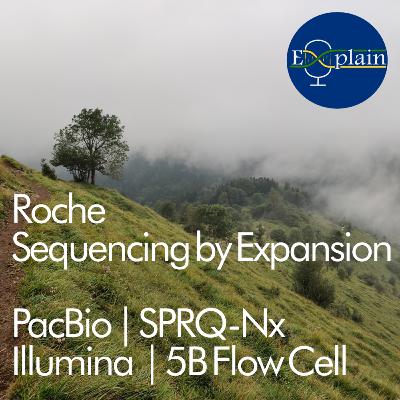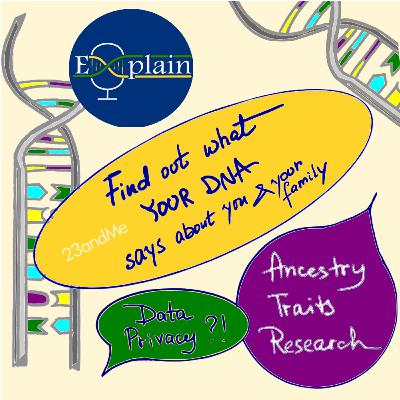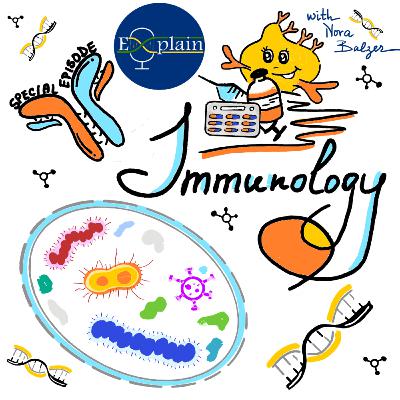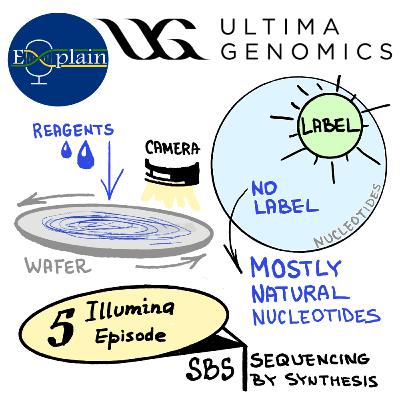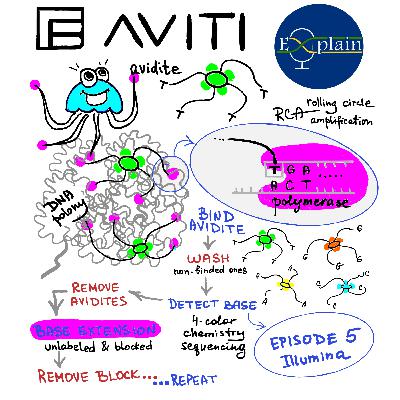Discover Explain Podcast
Explain Podcast

Explain Podcast
Author: explain.pod
Subscribed: 3Played: 33Subscribe
Share
© explain.pod
Description
The Podcast Explain is for everyone interested in DNA/RNA sequencing or technology in general. As Iuliia doesn't have a solid background in sequencing, she keeps asking "simple" - even silly at times - questions and Daniel gives his best to make us understand.
23 Episodes
Reverse
Who needs all bases anyway?Chapters:00:00 Phasing08:50 Not Sequencing, really14:00 Bionano Saphyr Chip26:00 Nabsys - going electric29:30 Tools available39:00 QuickGen with Iuliia: Transposons!Links:Small explainer by CAP: https://www.cap.org/member-resources/articles/optical-genome-mapping-a-tool-with-significant-potential-from-discovery-to-diagnosticsWhat genome mapping can be used for: https://www.mdpi.com/2073-4425/12/3/398Finding SVs with genome mapping: https://www.nature.com/articles/s41408-024-01059-xBionano github repos: https://github.com/search?q=bionano&type=repositories&s=updated&o=descListen to our podcast and send your feedback to podcast[dot]explain[at]gmail[dot]comSince 2019, West German Genome Center https://wggc.de/ operates as the nextgeneration sequencing facility and supports research in genomics & transcriptomics by providing expertise and sequencing services. WGGC is a part of the Next Generation Sequencing Competence Network NGS-CN https://ngs-cn.de/ – network of NGS core facilities in Germany.The Explain Podcast is recorded at the Multimediazentrum at Heinrich-Heine University ofDüsseldorf https://www.mmz.hhu.de/ Our podcast is an outreach activity within the national genomics facility ”West German Genome Center” funded by the Ministerium für Kultur und Wissenschaft des Landes Nordrhein-Westfalen https://www.mkw.nrw/land-foerdert-spitzenzentrum-fuer-genomsequenzierung-nordrhein-westfalen/License NoticeThis podcast including all episodes, unless otherwise noted, is licensed under a Creative Commons Attribution 4.0 International License.You are free to share, remix, and use this content as long as you give appropriate credit, provide a link to the license, and indicate if changes were made.Attribution:Podcast Title: Explain PodcastCreators: Iuliia Novoselova, Daniel RickertWebsite: https://ngs-cn.de/explain-podcast/
H+ ions and where we can find themChapters:00:00 Intro04:26 pH08:04 DNA Polymerase reaction with H+12:30 Nucleotides16:30 Homopolymer problem, but different19:30 PCR is mean to some bases24:30 AmpliSeq33:40 Today’s status38:58 cfDNA40:00 PHRED vs Qscore44:59 Chip scaling and prices51:00 Outro- bitesizedbio on the technology:https://bitesizebio.com/27399/all-in-the-chip-ion-torrent-sequencers/- Quick explainer from Basic Biochem: https://www.youtube.com/watch?v=vMUnN2Y48Us- Slideshow giving an overview:https://www.slideshare.net/USDBioinformatics/ion-torrent-sequencing- biobinge explaining Iontorrent sequencing:https://biobinge.pubpub.org/pub/its/release/1- rna-seqblog showing a comparison to Illumina:https://www.rna-seqblog.com/a-comparison-of-illumina-and-ion-torrent-sequencing-platforms-and-the-winner-is/- Explainer by Shomu’s Biology: https://www.youtube.com/watch?v=0Ch5189aaCUSince 2018, West German Genome Center (https://wggc.de/) operates as the next generation sequencing facility and supports research in genomics & transcriptomics by providing expertise and sequencing services. WGGC is a part of the Next Generation Sequencing Competence Network (NGS-CN: https://ngs-kn.de/) - network of NGS core facilities in Germany.Listen to our podcast and we're happy to receive your feedback&questions via Email ( podcast[dot]explain[at]gmail[dot]com ).The Explain Podcast is recorded at the Medienlabor at Heinrich-Heine University of Düsseldorf (https://medienlab.phil.hhu.de/).Our podcast is an outreach activity within the national genomics facility "West German Genome Center" funded by the DFG (https://www.dfg.de/) (No. 407493903).License NoticeThis podcast including all episodes, unless otherwise noted, is licensed under a Creative Commons Attribution 4.0 International License.You are free to share, remix, and use this content as long as you give appropriate credit, provide a link to the license, and indicate if changes were made.Attribution:Podcast Title: Explain PodcastCreators: Iuliia Novoselova, Daniel RickertWebsite: https://ngs-cn.de/explain-podcast/
If ligation is more your thing- Special Operations explaining SOLiD Sequencing: https://www.youtube.com/watch?v=YLT-DUeaLms- Writeup by the Apollo Institute on SOLiD Sequencing: https://apollo-institute.org/solid-sequencing/- Quick run-through video by ABI: https://www.youtube.com/watch?v=nlvyF8bFDwM- Ars technica about the technology:https://arstechnica.com/science/2009/12/dna-sequencing-gets-solid-with-built-in-error-detection/- atdbio explaining SOLiD sequencing:https://atdbio.com/nucleic-acids-book/Next-generation-sequencing#Sequencing-by-ligation-SOLiD- Biogene Blog on SOLiD sequencers:https://www.creative-biogene.com/blog/index.php/2017/02/22/the-next-generation-sequencing-platform-of-abi-company/Chapters:00:00 Intro02:45 Ligation06:50 Getting hairy balls20:00 Bead 1 with DNA polonies23:30 6 Base Jokers24:00 2-Base encoding colours29:15 Offsets and holes35:00 Randomness and barcodes37:25 Chemistry summary40:30 Homopolymers are not the problem46:30 SOLiDs fateSince 2018, West German Genome Center (https://wggc.de/) operates as the next generation sequencing facility and supports research in genomics & transcriptomics by providing expertise and sequencing services. WGGC is a part of the Next Generation Sequencing Competence Network (NGS-CN: https://ngs-kn.de/) - network of NGS core facilities in Germany.Listen to our podcast and we're happy to receive your feedback&questions via Email ( podcast[dot]explain[at]gmail[dot]com ).The Explain Podcast is recorded at the Medienlabor at Heinrich-Heine University of Düsseldorf (https://medienlab.phil.hhu.de/).Our podcast is an outreach activity within the national genomics facility "West German Genome Center" funded by the DFG (https://www.dfg.de/) (No. 407493903).License NoticeThis podcast including all episodes, unless otherwise noted, is licensed under a Creative Commons Attribution 4.0 International License.You are free to share, remix, and use this content as long as you give appropriate credit, provide a link to the license, and indicate if changes were made.Attribution:Podcast Title: Explain PodcastCreators: Iuliia Novoselova, Daniel RickertWebsite: https://ngs-cn.de/explain-podcast/
After 454 now the second try by Roche.Correction: the 5B flow cell will arrive for the NovaseqX(+), not for the Nextseq2000Also:PacBio makes sequencing cheaper: https://www.pacb.com/press_releases/pacbio-announces-major-advances-for-revio-and-vega-to-lower-genome-cost-and-expand-multiomic-capabilities/Roche about SBX: https://sequencing.roche.com/global/en/article-listing/sequencing-platform-technologies.htmlRoche from a conference: https://www.youtube.com/watch?v=YN2meswiCiQSince 2018, West German Genome Center (https://wggc.de/) operates as the next generation sequencing facility and supports research in genomics & transcriptomics by providing expertise and sequencing services. WGGC is a part of the Next Generation Sequencing Competence Network (NGS-CN: https://ngs-kn.de/) – network of NGS core facilities in Germany. Listen to our podcast and we're happy to receive your feedback&questions via Email (podcast[dot]explain[at]gmail[dot]com ).License NoticeThis podcast including all episodes, unless otherwise noted, is licensed under a Creative Commons Attribution 4.0 International License.You are free to share, remix, and use this content as long as you give appropriate credit, provide a link to the license, and indicate if changes were made.Attribution:Podcast Title: Explain PodcastCreators: Iuliia Novoselova, Daniel RickertWebsite: https://ngs-cn.de/explain-podcast/
This time something different.Sources:https://www.23andme.com/privacy/https://verbraucherschutzforum.berlin/2025-03-25/23andme-meldet-insolvenz-an-was-nutzer-jetzt-wissen-sollten-357738/https://en.wikipedia.org/wiki/23andMe_data_leakhttps://www.cshub.com/attacks/news/23andme-hacker-leaks-datahttps://www.cbsnews.com/news/dna-privacy-at-home-tests-23andme-ancestrydna-sell-data-to-third-parties/https://techcrunch.com/2025/03/24/23andme-faces-an-uncertain-future-so-does-your-genetic-data/https://www.theverge.com/2024/9/13/24243986/23andme-settlement-dna-data-breach-lawsuithttps://newsroom.regeneron.com/news-releases/news-release-details/regeneron-enters-asset-purchase-agreement-acquire-23andmer-256/
The science of white blood cells, and much moreChapters:05:30 Immunology how?22:05 22q11.2 deletion syndrome34:30 Scientific collaboration40:00 Data losses50:00 Flip it!53:00 outlook 2030Links:mini-immunology intro:https://www.youtube.com/watch?v=k9QAyP3bYmc22Q e. V. - zentraler Anlaufpunkt für Menschen mit Deletionssyndrom 22q11 oder Duplikationssyndrom 22q11 im deutschsprachigen Raum https://www.wirsind22q.de/aus-dem-verein/vorstandPodcast for young immunologists from young immunologists https://theyoungimmunologist.buzzsprout.com/Contact Nora here https://www.linkedin.com/in/nora-balzer-phd-253a767bSome information about training courses and events https://www.immunology.org/traininghttps://dgfi.org/dgfi-en/academy-of-immunology/Since 2018, West German Genome Center (https://wggc.de/) operates as the next generation sequencing facility and supports research in genomics & transcriptomics by providing expertise and sequencing services. WGGC is a part of the Next Generation Sequencing Competence Network (NGS-CN: https://ngs-kn.de/) – network of NGS core facilities in Germany. Listen to our podcast and we're happy to receive your feedback&questions via Email (podcast[dot]explain[at]gmail[dot]com ).License NoticeThis podcast including all episodes, unless otherwise noted, is licensed under a Creative Commons Attribution 4.0 International License.You are free to share, remix, and use this content as long as you give appropriate credit, provide a link to the license, and indicate if changes were made.Attribution:Podcast Title: Explain PodcastCreators: Iuliia Novoselova, Daniel RickertWebsite: https://ngs-cn.de/explain-podcast/
Sharing a flowcell, reinventedChapters:- 00:00 usegalaxy.org- 07:55 Singular Genomics start- 21:55 Max Reads- 29:40 DNA Structure / ATAC-seqSetup galaxy on local hardware: https://galaxyproject.org/admin/get-galaxy/G4 is competing with Illumina:https://www.genengnews.com/topics/omics/fast-and-flexible-singulars-g4-takes-aim-at-illuminas-sequencing-superiority/Singulars chemistry is one of many:https://www.nature.com/articles/d41586-023-00512-4How max reads works:https://techwriting.singulargenomics.com/max-read/Max-Read-Kit-User-Guide-600026.pdfSmall intro to DNA Structures:https://en.wikipedia.org/wiki/Nucleic_acid_quaternary_structureIntro to ATAC-seq:https://www.nature.com/articles/s41596-022-00692-9PS:As of 2025, Singular does not advertise DNA/RNA Sequencing on their G4 anymore, but shifted to spatial data, including their G4X: https://www.singulargenomics.com/Since 2018, West German Genome Center (https://wggc.de/) operates as the next generation sequencing facility and supports research in genomics & transcriptomics by providing expertise and sequencing services. WGGC is a part of the Next Generation Sequencing Competence Network (NGS-CN: https://ngs-kn.de/) – network of NGS core facilities in Germany. Listen to our podcast and we're happy to receive your feedback&questions via Email (podcast[dot]explain[at]gmail[dot]com ).License NoticeThis podcast including all episodes, unless otherwise noted, is licensed under a Creative Commons Attribution 4.0 International License.You are free to share, remix, and use this content as long as you give appropriate credit, provide a link to the license, and indicate if changes were made.Attribution:Podcast Title: Explain PodcastCreators: Iuliia Novoselova, Daniel RickertWebsite: https://ngs-cn.de/explain-podcast/
Spinnin' bases on wafers to do mostly natural SBSChapters:- 00:00 Ultima ePCR with beads- 07:10 Spinning the wafer, nucleotides, no blocking- 14:30 Ultima ppmSeq + Element UltraQ- 25:30 How Element UltraQ was born- 30:30 snakemake, cromwell, nextflow- 36:50 ncRNAUltimas homepage: https://www.ultimagenomics.com/Nature paper with the chemistry: https://www.nature.com/articles/s41587-022-01452-6Elements UltraQ chemistry:https://www.elementbiosciences.com/cloudbreak-ultraq-enhanced-sequencing-accuracy-when-precision-matters-mostSnakemake: https://snakemake.readthedocs.io/en/stable/Nextflow: https://www.nextflow.io/docs/latest/index.htmlCromwell: https://cromwell.readthedocs.io/en/stable/Small overview of not all ncRNA types: https://microbenotes.com/types-of-rna/Since 2018, West German Genome Center (https://wggc.de/) operates as the next generation sequencing facility and supports research in genomics & transcriptomics by providing expertise and sequencing services. WGGC is a part of the Next Generation Sequencing Competence Network (NGS-CN: https://ngs-kn.de/) – network of NGS core facilities in Germany. Listen to our podcast and we're happy to receive your feedback&questions via Email (podcast[dot]explain[at]gmail[dot]com ).License NoticeThis podcast including all episodes, unless otherwise noted, is licensed under a Creative Commons Attribution 4.0 International License.You are free to share, remix, and use this content as long as you give appropriate credit, provide a link to the license, and indicate if changes were made.Attribution:Podcast Title: Explain PodcastCreators: Iuliia Novoselova, Daniel RickertWebsite: https://ngs-cn.de/explain-podcast/
Because sometimes a jellyfish prevents quenchingChapters:01:00 - XLeap update from Illumina08:00 - Avidites start, splitting the problems13:20 - In-depth comparison to Illumina22:00 - Element summary23:30 - Bioinformatics tools: Jellyfish, KAT25:00 - QuickGen: GWASIllumina about their XLeap: https://www.illumina.com/science/genomics-research/articles/data-quality-q-scores.htmlSandiegomics about element: https://sandiegomics.com/element-beats-illumina-to-the-200-genome/Nature paper about the chemistry: https://www.nature.com/articles/s41587-023-01750-7Jellyfish for k-mer counting: https://github.com/gmarcais/JellyfishGWAS Catalog: very nice data collection: https://www.ebi.ac.uk/gwas/diagramCorrecting population-based GWAS bias: https://journals.plos.org/plosgenetics/article?id=10.1371/journal.pgen.1011242Since 2018, West German Genome Center (https://wggc.de/) operates as the next generation sequencing facility and supports research in genomics & transcriptomics by providing expertise and sequencing services. WGGC is a part of the Next Generation Sequencing Competence Network (NGS-CN: https://ngs-kn.de/) - network of NGS core facilities in Germany. Listen to our podcast and we're happy to receive your feedback&questions via Email (podcast[dot]explain[at]gmail[dot]com ).License NoticeThis podcast including all episodes, unless otherwise noted, is licensed under a Creative Commons Attribution 4.0 International License.You are free to share, remix, and use this content as long as you give appropriate credit, provide a link to the license, and indicate if changes were made.Attribution:Podcast Title: Explain PodcastCreators: Iuliia Novoselova, Daniel RickertWebsite: https://ngs-cn.de/explain-podcast/
Because only one type of nucleotide is not complicated enoughChapters:01:35 Introducing old problems15:30 More Phred, more better34:40 QuickGen: genetic testing47:40 Bioinformatics tools: samtoolsPacBio ONSO Specs: https://www.pacb.com/wp-content/uploads/Onso-specification-sheet.pdfSBB explained by PacBio: https://www.pacb.com/blog/sbb-sequencing/Why higher quality is better: https://pmc.ncbi.nlm.nih.gov/articles/PMC11331594/Short read sequencing market heating up: https://www.nature.com/articles/s41587-022-01632-4SBB for visual learners: https://www.youtube.com/watch?v=i_mSaNBOVmQSince 2018, West German Genome Center (https://wggc.de/)operates as the next generation sequencing facility and supports research in genomics & transcriptomics by providing expertise and sequencing services. WGGC is a part of the Next Generation Sequencing Competence Network (NGS-CN: https://ngs-kn.de/) - network of NGS core facilities in Germany. Listen to our podcast and we're happy to receive your feedback&questions via Email (podcast[dot]explain[at]gmail[dot]com ).License NoticeThis podcast including all episodes, unless otherwise noted, is licensed under a Creative Commons Attribution 4.0 International License.You are free to share, remix, and use this content as long as you give appropriate credit, provide a link to the license, and indicate if changes were made.Attribution:Podcast Title: Explain PodcastCreators: Iuliia Novoselova, Daniel RickertWebsite: https://ngs-cn.de/explain-podcast/
Mixing up long and cheapChapters:00:00:00 Intro00:03:30 Florians history00:13:50 Q&A Ressources for Bioinformatics00:27:00 Long-read-tools.org00:35:42 ONT || PacBio00:57:00 Storage01:09:00 OutroUp-to-date, raw prices:https://albertvilella.substack.com/p/march-2024-ngsspecs-updateDovetail comparing the two long-read technologies:https://dovetailbiopartners.com/2023/08/10/pacbio-vs-nanopore-unraveling-the-sequencing-odyssey-in-life-sciences/Comparing PacBios old CLRs to ONT:https://academic.oup.com/g3journal/article/12/11/jkac192/6651842?login=trueRNA Performance comparison, wonderful read:https://www.biorxiv.org/content/10.1101/2023.07.25.550582v1.full.pdf+htmlIntegras 0.02$:https://www.integra-biosciences.com/united-states/en/blog/article/short-read-vs-long-read-sequencingSince 2018, West German Genome Center (https://wggc.de/) operates as the next generation sequencing facility and supports research in genomics & transcriptomics by providing expertise and sequencing services. WGGC is a part of the Next Generation Sequencing Competence Network (NGS-CN: https://ngs-kn.de/) - network of NGS core facilities in Germany. Listen to our podcast and we're happy to receive your feedback&questions via Email (podcast[dot]explain[at]gmail[dot]com ).Our podcast is an outreach activity within the national genomics facility "West German Genome Center" funded by the DFG (https://www.dfg.de/) (No. 407493903)License NoticeThis podcast including all episodes, unless otherwise noted, is licensed under a Creative Commons Attribution 4.0 International License.You are free to share, remix, and use this content as long as you give appropriate credit, provide a link to the license, and indicate if changes were made.Attribution:Podcast Title: Explain PodcastCreators: Iuliia Novoselova, Daniel RickertWebsite: https://ngs-cn.de/explain-podcast/
Rolling in circles to make DNA yarnsChapters:00:00 Bioinformatics Upper Crust Tools04:04 STAR05:00 MGI15:00 Daniels first contact20:00 Brief Market Overview22:30 Short read market26:00 DFG High Costs Sequencing Projects Application29:20 QuickGen: Introns and Exons35:00 ConclusionMGI vs Illumina: https://alitheagenomics.com/blog/how-do-rna-seq-results-compare-between-illumina-and-mgi-sequencing-platformsRolling the circle: https://www.ncbi.nlm.nih.gov/pmc/articles/PMC5568012/pdf/nihms894568.pdfMGI vs Illumina legal case:https://www.reuters.com/technology/illumina-ordered-pay-chinese-company-333-million-gene-sequencing-patent-case-2022-05-06/The basics of MGIs technology: https://www.youtube.com/watch?v=gThcHHh4R0wDFG Application:https://www.dfg.de/de/aktuelles/neuigkeiten-themen/info-wissenschaft/2024/ifw-24-30GTL/WGGC: https://www.gtl.hhu.de/wggcTSM link http://tsm.gtl.hhu.de/- submit your request and our colleagues will contact youSince 2018, West German Genome Center https://wggc.de/) operates as the next generation sequencing facility and supports research in genomics & transcriptomics by providing expertise and sequencing services. WGGC is a part of the Next Generation Sequencing Competence Network (NGS-CN: https://ngs-kn.de/) - network of NGS core facilities in Germany.Listen to our podcast and we're happy to receive yourfeedback&questions via Email ( podcast[dot]explain[at]gmail[dot]com ).Our podcast is an outreach activity within the national genomics facility "West German Genome Center" funded by the DFG (https://www.dfg.de/) (No. 407493903)License NoticeThis podcast including all episodes, unless otherwise noted, is licensed under a Creative Commons Attribution 4.0 International License.You are free to share, remix, and use this content as long as you give appropriate credit, provide a link to the license, and indicate if changes were made.Attribution:Podcast Title: Explain PodcastCreators: Iuliia Novoselova, Daniel RickertWebsite: https://ngs-cn.de/explain-podcast/
Chapters:00:00 Gambling15:00 Bubbles30:00 Holes57:30 One more thing1:07:00 Finale1:08:00 Finale of season 1!Eric Chow explaining single cell sequencing: https://www.youtube.com/watch?v=k9VFNLLQP8cOverview of things to consider: https://www.youtube.com/watch?v=VWUPKrnRvoQHow to analyze single cell data: https://www.youtube.com/watch?v=5HBzgsz8qykA very good single cell analysis toolkit: https://satijalab.org/seurat/Explainer for the rough workflow:https://www.technologynetworks.com/genomics/articles/understanding-single-cell-sequencing-how-it-works-and-its-applications-357578Quick explainer on single cell sequencing:https://www.the-scientist.com/single-cell-sequencing-in-a-nutshell-71048A method-overview paper: https://www.nature.com/articles/s12276-020-00499-2Comparing BD Parse and 10xGenomics: https://pubmed.ncbi.nlm.nih.gov/33414681/Pseudotime analysis: https://bioconductor.org/books/3.14/OSCA.advanced/trajectory-analysis.htmlSince 2018, West German Genome Center (https://wggc.de/) operates as the next generation sequencing facility and supports research in genomics & transcriptomics by providing expertise and sequencing services. WGGC is a part of the Next Generation Sequencing Competence Network (NGS-CN: https://ngs-kn.de/) - network of NGS core facilities in Germany.Listen to our podcast and send your feedback to ( podcast[dot]explain[at]gmail[dot]com ).The Explain Podcast is recorded at the Medienlabor at Heinrich-Heine University of Düsseldorf (https://medienlab.phil.hhu.de/). Our podcast is an outreach activity within the national genomics facility "West German Genome Center" funded by the DFG (https://www.dfg.de/) (No. 407493903).PS: I do not know how in the Parse approach the cells are treated to let the ligase and DNA enter each cell, but do not let RNA flow out of the cell at the same time. -DRLicense NoticeThis podcast including all episodes, unless otherwise noted, is licensed under a Creative Commons Attribution 4.0 International License.You are free to share, remix, and use this content as long as you give appropriate credit, provide a link to the license, and indicate if changes were made.Attribution:Podcast Title: Explain PodcastCreators: Iuliia Novoselova, Daniel RickertWebsite: https://ngs-cn.de/explain-podcast/
Getting the most out of MachinesChapters:00:00 PhiX14:30 low complexity19:30 UMIs32:10 FastQC43:00 MultiQC56:40 PycoQCPhiX concentrations for loading a validation run:https://knowledge.illumina.com/instrumentation/general/instrumentation-general-reference_material-list/000001536Dnatech on why UMIs are used:https://dnatech.genomecenter.ucdavis.edu/faqs/what-are-umis-and-why-are-they-used-in-high-throughput-sequencing/BMH learning on UMIs: https://www.youtube.com/watch?v=sRPMsnhIBK0FastQC for QC of .fastq(.gz) files:https://www.bioinformatics.babraham.ac.uk/projects/fastqc/A FastQC report from a „good“ sample:https://www.bioinformatics.babraham.ac.uk/projects/fastqc/good_sequence_short_fastqc.htmlmultiqc for summarizing QC reports: https://multiqc.info/UMI-tools for working with UMI data: https://umi-tools.readthedocs.io/en/latest/pycoQC for Nanopore QC: https://github.com/a-slide/pycoQCSince 2018, West German Genome Center (https://wggc.de/)operates as the next generation sequencing facility and supportsresearch in genomics & transcriptomics by providing expertise andsequencing services. WGGC is a part of the Next Generation Sequencing Competence Network (NGS-CN: https://ngs-kn.de/)- network of NGS core facilities in Germany. Listen to our podcast and we're happy to receive your feedback&questions via Email (podcast[dot]explain[at]gmail[dot]com ).The Explain Podcast is recorded at the Medienlabor atHeinrich-Heine University of Düsseldorf (https://medienlab.phil.hhu.de/). Our podcast is an outreach activity within the national genomics facility "West German Genome Center" funded by the DFG (https://www.dfg.de/) (No. 407493903).License NoticeThis podcast including all episodes, unless otherwise noted, is licensed under a Creative Commons Attribution 4.0 International License.You are free to share, remix, and use this content as long as you give appropriate credit, provide a link to the license, and indicate if changes were made.Attribution:Podcast Title: Explain PodcastCreators: Iuliia Novoselova, Daniel RickertWebsite: https://ngs-cn.de/explain-podcast/
Pushing spaghetti through holesChapers:00:00 Intro11:15 Measuring Ions17:00 Quality23:00 Duplex24:30 MinION25:15 PromethION28:20 Methylation29:00 Direct RNA sequencing38:25 Basecalling46:00 Basecalling bias53:50 Sequencing proteins- Nanopore explainer: https://nanoporetech.com/applications/dna-nanopore-sequencing- Oxsci explaining the technology:https://oxsci.org/pore-over-this-advances-in-dna-sequencing/- History of Nanopore:https://www.whatisbiotechnology.org/index.php/science/summary/nanopore/nanopore-sequencing-makes-it-possible-to-decode-the- Shmou’s Biology explaining Nanopore sequencing:https://www.youtube.com/watch?v=MlluAjhzXqI- A direct comparison of Nanopore and Illumina output:https://medresearch.umich.edu/office-research/about-office-research/biomedical-research-core-facilities/advanced-genomics-core/technologies/next-generation-sequencing- A nice Nanopore QC tool we use: https://hpc.nih.gov/apps/pycoQC.html- How a MinION looks like:https://www.whatech.com/og/markets-research/medical/658327-global-nanopore-sequencing-market-2020Since 2018, West German Genome Center (https://wggc.de/)operates as the next generation sequencing facility and supportsresearch in genomics & transcriptomics by providing expertise andsequencing services. WGGC is a part of the Next Generation Sequencing Competence Network (NGS-CN: https://ngs-kn.de/)- network of NGS core facilities in Germany.Listen to our podcast and we're happy to receive your feedback&questions via Email ( podcast[dot]explain[at]gmail[dot]com ).The Explain Podcast is recorded at the Medienlabor at Heinrich-Heine University of Düsseldorf (https://medienlab.phil.hhu.de/).Our podcast is an outreach activity within the national genomicsfacility "West German Genome Center" funded by the DFG(https://www.dfg.de/) (No. 407493903).License NoticeThis podcast including all episodes, unless otherwise noted, is licensed under a Creative Commons Attribution 4.0 International License.You are free to share, remix, and use this content as long as you give appropriate credit, provide a link to the license, and indicate if changes were made.Attribution:Podcast Title: Explain PodcastCreators: Iuliia Novoselova, Daniel RickertWebsite: https://ngs-cn.de/explain-podcast/
Zipping rounds in zeptolitersChapters:00:00 Intro 07:00 Laser09:00 Zeptoliters13:30 Polymerase speed19:00 Error rate22:00 SMRT Cell25:45 ccs30:00 Fragment size34:30 Megaruptor38:20 Data flow47:00 SVs53:00 MAS Seq- Starter: https://www.nature.com/articles/s41366-021-00824-3- Karobben on PacBio sequencing: https://karobben.github.io/2023/10/30/Bioinfor/PacBio/- bioinformticamente explaining the technology:https://bioinformaticamente.com/2020/12/05/pacbio-sequencing/- Basic Biochem explainer of SMRT sequencing:https://www.youtube.com/watch?v=H2gUmRf-K1c- Genomics Lab explaining it: https://www.youtube.com/watch?v=vRhUSjhygDU- PacBio explaining BAM Tags: https://pacbiofileformats.readthedocs.io/en/13.0/BAM.html- Megaruptor3 explainer (how we make the right sized fragments) :https://www.youtube.com/watch?v=zVhqnkQL8zo- How we select the right sized fragments: https://www.youtube.com/watch?v=A25C8xfBbq8Since 2018, West German Genome Center (https://wggc.de/)operates as the next generation sequencing facility and supportsresearch in genomics & transcriptomics by providing expertise andsequencing services. WGGC is a part of the Next Generation Sequencing Competence Network (NGS-CN: https://ngs-kn.de/)- network of NGS core facilities in Germany. Listen to our podcast and we're happy to receive your feedback&questions via Email (podcast[dot]explain[at]gmail[dot]com ).The Explain Podcast is recorded at the Medienlabor at Heinrich-Heine University of Düsseldorf (https://medienlab.phil.hhu.de/).Our podcast is an outreach activity within the national genomicsfacility "West German Genome Center" funded by the DFG(https://www.dfg.de/) (No. 407493903).License NoticeThis podcast including all episodes, unless otherwise noted, is licensed under a Creative Commons Attribution 4.0 International License.You are free to share, remix, and use this content as long as you give appropriate credit, provide a link to the license, and indicate if changes were made.Attribution:Podcast Title: Explain PodcastCreators: Iuliia Novoselova, Daniel RickertWebsite: https://ngs-cn.de/explain-podcast/
Glued DNA bridges and rainbow clustersChapters:00:00-Flowcells03:40-DNA glued to glass09:00-Bridge amplification15:50-Cluster density and patterned Flowcells28:30-Illumina SBS summary30:30-Limits33:00-Multiplexing and Demultiplexing- enseqlopedia on patterned vs unpatterned flowcell:http://enseqlopedia.com/2016/01/almost-everything-you-wanted-to-know-about-illumina-hiseq-4000-and-some-stuff-you-didnt/- ClevaLabs on Illumina sequencing: https://www.youtube.com/watch?v=WKAUtJQ69n8- Yourgenome on how the Illumina workflow works:https://www.yourgenome.org/facts/what-is-the-illumina-method-of-dna-sequencing/- DNATech comparing Illumina Machines:https://dnatech.genomecenter.ucdavis.edu/illumina-high-throughput-sequencing/- iBiology on sample preparation for Illumina sequencing:https://www.youtube.com/watch?v=PFwSe09dJX0- StatQuest on how to use Illumina sequencing for RNA analysis:https://www.youtube.com/watch?v=tlf6wYJrwKY- Illumina Flowcell and sequencing machines pictures:https://www.illumina.com/company/news-center/multimedia-images.html- Nice explainer about paired-end sequencing:https://www.youtube.com/watch?v=gVrmfLXJRGMSince 2018, West German Genome Center (https://wggc.de/)operates as the next generation sequencing facility and supportsresearch in genomics & transcriptomics by providing expertise andsequencing services. WGGC is a part of the Next Generation Sequencing Competence Network (NGS-CN: https://ngs-kn.de/)- network of NGS core facilities in Germany. Listen to our podcast and send your feedback to ( podcast[dot]explain[at]gmail[dot]com ).The Explain Podcast is recorded at the Medienlabor at Heinrich-Heine University of Düsseldorf (https://medienlab.phil.hhu.de/).Our podcast is an outreach activity within the national genomics facility "West German Genome Center" funded by the DFG (https://www.dfg.de/) (No. 407493903).Clarification: Each Flowcell on the Illumina platform has 1-8channels, each channel can be filled with multiple different samples- DRLicense NoticeThis podcast including all episodes, unless otherwise noted, is licensed under a Creative Commons Attribution 4.0 International License.You are free to share, remix, and use this content as long as you give appropriate credit, provide a link to the license, and indicate if changes were made.Attribution:Podcast Title: Explain PodcastCreators: Iuliia Novoselova, Daniel RickertWebsite: https://ngs-cn.de/explain-podcast/
Colour mixing in PHRED spaceChapters:00:00 Nucleotides level 209:00 Cycles12:00 Not-so-wobbly mutations15:30 Reducing colourspace22:30 Cutting connections28:14 Costs and PHRED- ClevaLabs on Illumina sequencing: https://www.youtube.com/watch?v=WKAUtJQ69n8- Yourgenome on how the Illumina workflow works:https://www.yourgenome.org/facts/what-is-the-illumina-method-of-dna-sequencing/- DNATech comparing Illumina Machines:https://dnatech.genomecenter.ucdavis.edu/illumina-high-throughput-sequencing/- iBiology on sample preparation for Illumina sequencing:https://www.youtube.com/watch?v=PFwSe09dJX0- StatQuest on how to use Illumina sequencing for RNA analysis:https://www.youtube.com/watch?v=tlf6wYJrwKY- Illumina Flowcell and sequencing machines pictures:https://www.illumina.com/company/news-center/multimedia-images.html- Nice explainer about paired-end sequencing:https://www.youtube.com/watch?v=gVrmfLXJRGMSince 2018, West German Genome Center (https://wggc.de/)operates as the next generation sequencing facility and supportsresearch in genomics & transcriptomics by providing expertise andsequencing services. WGGC is a part of the Next Generation Sequencing Competence Network (NGS-CN: https://ngs-kn.de/)- network of NGS core facilities in Germany.Listen to our podcast and send your feedback to ( podcast[dot]explain[at]gmail[dot]com ).The Explain Podcast is recorded at the Medienlabor at Heinrich-Heine University of Düsseldorf (https://medienlab.phil.hhu.de/).Our podcast is an outreach activity within the national genomics facility "West German Genome Center" funded by the DFG (https://www.dfg.de/) (No. 407493903).CORRECTION: On the Illumina 1-channel chemistry, one base signal gets added, one removed at the enzymatic step: so that's one signal that stays, one that disappears, one that comes to shine and one that never shines. - DRLicense NoticeThis podcast including all episodes, unless otherwise noted, is licensed under a Creative Commons Attribution 4.0 International License.You are free to share, remix, and use this content as long as you give appropriate credit, provide a link to the license, and indicate if changes were made.Attribution:Podcast Title: Explain PodcastCreators: Iuliia Novoselova, Daniel RickertWebsite: https://ngs-cn.de/explain-podcast/
Iuliia killed the stripey catChapters:00:00 Intro00:04:44 Stripes00:11:40 Sanger with colors00:17:20 CATCATCAT...00:33:20 Planes00:38:15 Genome assembly00:40:00 Transcriptomics01:01:00 Hi-C Why women are stripey: https://www.youtube.com/watch?v=BD6h-wDj7bwFuture-science about str profiling: https://www.future-science.com/doi/10.2144/000112582Mark Santucci explaining str profiles: https://www.youtube.com/watch?v=Eg3gH2wmAW8NIJ explaining the theory for beginners:https://nij.ojp.gov/topics/articles/what-str-analysisMIT on genome assembly: https://www.youtube.com/watch?v=ZYW2AeDE6wUFundamentals of genome assembly by Bioinformatics DotCa:https://www.youtube.com/watch?v=5wvGapmA5zMGenome assembly tips from F1000Research:https://www.ncbi.nlm.nih.gov/pmc/articles/PMC5850084/CD Genomics explaining some genome assembly metrics:https://www.cd-genomics.com/an-overview-of-genome-assembly.htmlGeneticeducation giving an intro to transcriptomics:https://geneticeducation.co.in/what-is-transcriptomics/A slideshare explaining transcriptomics:https://www.slideshare.net/divyasrivastava17/transcriptome-analysisHow to create a volcano plot in R:https://training.galaxyproject.org/training-material/topics/transcriptomics/tutorials/rna-seq-viz-with-volcanoplot-r/tutorial.htmlBioinformatic walk-through by the galaxy project with a typical RNA-Seq experiment:https://training.galaxyproject.org/training-material/topics/transcriptomics/tutorials/rna-seq-counts-to-genes/tutorial.htmlRNA splicing explained by arpan: https://www.youtube.com/watch?v=IJQv1H-2IoIkhanacademy on RNA processing:https://www.khanacademy.org/science/ap-biology/gene-expression-and-regulation/transcription-and-rna-processing/a/eukaryotic-pre-mrna-processingSince 2018, West German Genome Center (https://wggc.de/)operates as the next generation sequencing facility and supportsresearch in genomics & transcriptomics by providing expertise andsequencing services. WGGC is a part of the Next Generation Sequencing Competence Network (NGS-CN: https://ngs-kn.de/)- network of NGS core facilities in Germany.Listen to our podcast and we're happy to receive your feedback&questions via Email ( podcast[dot]explain[at]gmail[dot]com ).The Explain Podcast is recorded at the Medienlabor atHeinrich-Heine University of Düsseldorf(https://medienlab.phil.hhu.de/).Our podcast is an outreach activity within the national genomicsfacility "West German Genome Center" funded by the DFG(https://www.dfg.de/) (No.407493903).License NoticeThis podcast including all episodes, unless otherwise noted, is licensed under a Creative Commons Attribution 4.0 International License.You are free to share, remix, and use this content as long as you give appropriate credit, provide a link to the license, and indicate if changes were made.Attribution:Podcast Title: Explain PodcastCreators: Iuliia Novoselova, Daniel RickertWebsite: https://ngs-cn.de/explain-podcast/
Iuliia and Daniel have fun with salt water and alcoholChapters:00:00:00 DIY DNA isolation 00:15:38 Directed evolution of EnzymesDNA isolation in your kitchen- Experiment during the episode: https://www.instructables.com/How-to-Extract-Your-Own-DNA-Using-Household-Kitche/- Another protocol with the same approach: https://learning-center.homesciencetools.com/article/how-to-extract-dna-at-home/- Extract DNA from a strawberry: https://www.popsci.com/diy/diy-science-project-strawberrry-dna/- Banana DNA extraction: https://askabiologist.asu.edu/activities/banana-dnaBONUS:Directed, artifical evolution of enzymes:- Where it comes from:https://www.nobelprize.org/prizes/chemistry/2018/arnold/facts/ - Chemistryworld about the idea:https://www.chemistryworld.com/news/what-is-directed-evolution-and-why-did-it-win-the-chemistry-nobel-prize/3009584.article- A few of many results of this method: https://pdb101.rcsb.org/motm/228- MIT News about adding robots to this:https://news.mit.edu/2021/robotic-directed-evolution-molecules-1230Since 2018, West German Genome Center (https://wggc.de/) operates as the next generation sequencing facility and supports research in genomics & transcriptomics by providing expertise and sequencing services. WGGC is a part of the Next Generation Sequencing Competence Network (NGS-CN: https://ngs-kn.de/) - network of NGS core facilities in Germany.Listen to our podcast and send your feedback to ( podcast[dot]explain[at]gmail[dot]com ).The Explain Podcast is recorded at the Medienlabor at Heinrich-Heine University of Düsseldorf (https://medienlab.phil.hhu.de/). Our podcast is an outreach activity within the national genomics facility "West German Genome Center" funded by the DFG (https://www.dfg.de/) (No. 407493903).License NoticeThis podcast including all episodes, unless otherwise noted, is licensed under a Creative Commons Attribution 4.0 International License.You are free to share, remix, and use this content as long as you give appropriate credit, provide a link to the license, and indicate if changes were made.Attribution:Podcast Title: Explain PodcastCreators: Iuliia Novoselova, Daniel RickertWebsite: https://ngs-cn.de/explain-podcast/





